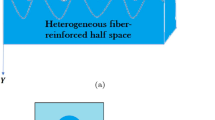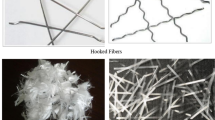Concrete as a material is brittle, but adding short steel fibers to the matrix can significantly improve its mechanical properties. The chemical adhesion between concrete and steel is weak, and the fiber pullout properties are based on fiber geometry and frictional forces. Single-fiber pullout tests of steel fibers with toothed and smooth surfaces were performed in order to characterize the effects of fiber surface facture. The influence of fiber form, surface facture, and fiber orientation (relative to the pullout direction) on the fiber withdrawal resistance and the maximum pullout force were studied.










Similar content being viewed by others
References
R. S. Olivito and F. A. Zuccarello, “An experimental study on the tensile strength of steel-fiber-reinforced concrete,” Composites: Part B, 41, 246-255 (2010).
Nemkumar Banthia and Jean-François Trottier, “Concrete reinforced with deformed steel fibers. 1: Bond slip mechanisms,” ACI Materials J.
Yun Lee, Su-Tae Kang, and Jin-Keun Kim, “Pullout behavior of inclined steel fiber in an ultra-high strength cementitious matrix,” Construction and Building Materials, 24, 2030-2041(2010).
C. K. Y. Leung, Associate Member, ASCE, and N. Shapiro, “Optimal steel fiber strength for reinforcement of cementitious materials,” J. of Mater. in Civil Eng., may, 116-123 (1999).
A. E. Naaman, G. G. Namur, J. M. Ahvan, and H. S. Najm, “Fiber pull-out and bond slip. II. Experimental validation,” J. Struct. Eng., 117, No. 9, 2791-2800 (1991).
P. Robins, S. Austin, and P. Jones, “Pull-out behavior of hooked steel fibres,” Mater. and Struct.,/Materiaux et Constructions, 35, August, 434-442 (2002).
D. G. Aggelis, D. V. Soulioti, N. M. Barkoula, A. S. Paipetis, and T. E. Matikas, “Influence of fiber chemical coating on the acoustic emission behavior of steel-fiber-reinforced concrete,” Cement and Concrete Composites, 34, 62-67 (2012).
D. V. Soulioti, N.-M. Barkoula, F. Koutsianopoulos, N. Charalambakis, and T. E. Matikas, “The effect of fibre chemical treatment on the steel fibre/cementitious matrix interface”, Construction and Building Materials 40 (2013) 77–83.
N. C. Kothari and E. A. Bonel, “Strength properties of concrete reinforced with epoxy-coated steel fibers,” ACI J., October, 550-553 (1978).
B. Banholzer, W. Brameshuber, and W. Jung, “Analytical simulation of pull-out tests — the direct problem,” Cement and Concrete Composites, 27, 93-101 (2005).
F. Laranjeira, C. Molins, and A. Aguado, “Predicting the pullout response of inclined hooked steel fibers,” Cement and Concrete Research, 40, 1471-1487 (2010).
B. Banholzer, W. Brameshuber, and W. Jung, “Analytical evaluation of pull-out tests — the inverse problem,” Cement and Concrete Composites, 28, 564-571 (2006).
J. M. Alwan, A. E. Naaman, and W. Hansen, “Pull-out work of steel fibers from cementitious composites: Analytical investigation,” Cement and Concrete Composites, 13, 247-255 (1991).
A. E. Naaman, Member, ASCE, G. G. Namur, J. M. Ahvan, and H. S. Najm, “Fiber pull-out and bond slip. I: Analytical study,” J. of Structural Engineering, 117, No. 9, 2769-2790 (1991).
A. Kelly and W. R. Tyson, High-Strength Materials. Wiley, New York, 1965
D. Hull and T. W. Clyne, An Introduction to Composite Materials. Cambridge University Press, Cambridge, 1981
A. E. Naaman, and H. N. Najm, “Bond slip mechanisms of steel fibers in concrete,” ACI Mater. J., 89, No. 2, 135-145 (1992).
J. Morton and G. W. Groves, “The cracking of composites consisting of discontinuous ductile fibres in a brittle matrix — effect of fibre orientation,” J. Mater. Sci., 9, 1436-1445 (1974).
V. C. Li, Y. Wang, and S. Baker, “Effect of inclining angle, bundling and surface treatment on synthetic fiber pull-out from a cement matrix,” Composites: 21, No. 2, 132-140 (1990).
Acknowledgments. This work has been funded by ERDF via project 2010/0293/2.1.1.1.0/10/APIA/VIA/073.
Author information
Authors and Affiliations
Corresponding author
Additional information
Translated from Mekhanika Kompozitnykh Materialov, Vol. 50, No. 4, pp. 615-626, July-August, 2014.
Rights and permissions
About this article
Cite this article
Zesers, A., Krūmiņš, J. Surface Properties of a Hooked Steel Fiber and their Effects on the Fiber Pullout and Composite Cracking 1. Experimental Study. Mech Compos Mater 50, 437–446 (2014). https://doi.org/10.1007/s11029-014-9430-2
Received:
Published:
Issue Date:
DOI: https://doi.org/10.1007/s11029-014-9430-2




